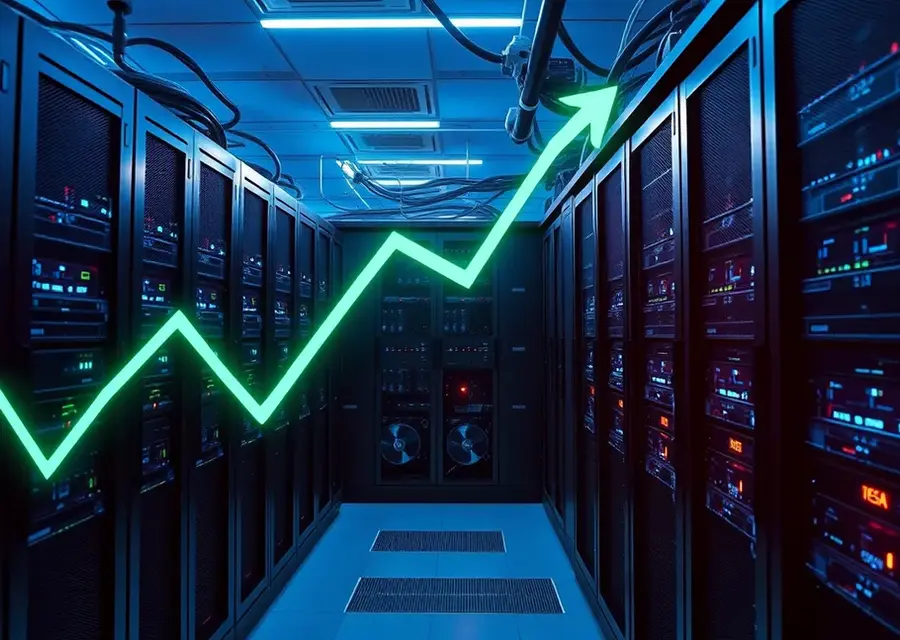CoreWeave stock analysis: Insider sell-off tests AI infrastructure momentum
- THE MAG POST

- Sep 11
- 9 min read

CoreWeave stock analysis: Insider waves map the AI infrastructure surge
Insider selling tracks the clock as lockups unwind, yet the AI infrastructure narrative keeps CoreWeave at the center of institutional curiosity.
Insider Selling Dynamics and Lockup Timelines
The past weeks have unfolded a conspicuous pattern: a wave of liquidity events initiated by major holders who seized the moment as post-IPO constraints dissolved. Magnetar Financial, along with its affiliates, has quietly transitioned tens of millions of dollars worth of CoreWeave shares into profit-taking alibis, illustrating a disciplined exit cadence rather than a reckless sell-off. The August window reportedly included roughly 2.4 million shares changing hands by insiders, with a large chunk executed on a single week and a robust tally from prior weeks. While the precise timing of each tranche aligns with the end of a standard lockup, the cumulative effect across multiple insiders signals a coordinated liquidity event rather than a panic retreat. For investors, the sequence raises a familiar question: are insiders monetizing ahead of a meaningful fundamental shift, or simply locking in gains after a rapid ascent? The scale of these transactions — tallied in mid-double-digit millions in a single month — underscores the gravity of the cash-out narrative and its potential to exert pressure on shares in the near term. Yet, the fact that insider sales are concentrated among a small cadre of sophisticated investors can also reflect a confidence in the longer-term business model despite near-term price volatility.
From a governance and incentives perspective, executives and board-aligned insiders are often guided by a mix of liquidity needs, diversification strategies, and personal wealth considerations. In CoreWeave’s case, CEO and general counsel involvement adds a nuanced layer: their sales can be read as a routine personal finance decision rather than a material information signal. Still, the optics of large disposals after a prolonged growth stretch can influence public perception and tilt sentiment toward caution. When timing aligns with earnings cadence and a fresh round of capital expenditure announcements, the market may interpret these moves as a market-price normalization rather than a fundamental flaw in the growth thesis. For advanced traders, monitoring the cadence of subsequent filings, the size of remaining positions, and any shifts in insider ownership can yield insights into how much conviction remains among early backers as CoreWeave scales its AI-centric data-center footprint.
Market Reactions and Fundamentals Under Pressure
The stock’s daily routine has become a study in volatility: a near-10% slide on a single trading session punctuated by a broader narrative of AI infrastructure demand that continues to expand. CoreWeave’s business momentum—an escalation in data-center deployments and GPU-enabled workloads—appears to paint a robust growth picture, even as the price action frays under the weight of insider cash-out. The revenue picture helps anchor the story: management has highlighted a revenue surge to roughly $1.15 billion in the latest quarter, up from around $400 million year-over-year, driven by heightened demand for AI-accelerated cloud services. Such expansion underscores a secular trend—enterprise-scale AI adoption—that could sustain needed capex and operating leverage. Yet, the market’s reaction to the unwind event introduces a cautionary tone: price declines can reflect shifting expectations about near-term earnings visibility, not just insider psychology. As investors reassess the balance sheet, they weigh the consumption of GPU infrastructure against the capital required to scale further into an AI-first data-center paradigm, mindful that exuberance can wane when sentiment sours faster than fundamentals evolve.
Moreover, competitive dynamics and supplier reliability remain critical variables. Nvidia GPUs, virtualization stacks, and the underlying cloud architecture form a complex ecosystem where performance hinges on a mix of hardware availability, software optimization, and network scalability. CoreWeave’s growth trajectory is inseparable from the broader AI hardware supply chain and the pace at which public cloud customers migrate workloads from traditional platforms to specialized AI-enabled environments. The risk factors are nontrivial: a potential deceleration in AI adoption, price competition among hyperscalers, or delayed customer conversions could compress margins and slow the pace of new data-center deployments. Even so, the company’s cadence of capacity expansion, if sustained, could translate into unit economics improvements and a longer-term durable advantage over peers that lack scale. The question before investors is whether today’s price discounts reflect a temporary pullback or a genuine shift in the growth multiple as the AI cycle matures.
Valuation and Strategic Positioning in AI Infrastructure
Two lines into CoreWeave’s narrative, the valuation lens is anchored in both momentum and durability. The market has observed a years-long tailwind for AI-enabled infrastructure, where data centers and GPU-accelerated services are essential to model training, inference, and real-time analytics. Investors are weighing near-term profitability against long-run demand that could sustain elevated capital expenditure. The stock’s recent move back toward the lower- to mid-$90s hints at a transition phase: prices reflect a blend of profit-taking risk and a renewed emphasis on cash flow generation and capacity utilization. In this context, the company’s earnings profile and revenue mix—where AI workloads and cloud services constitute a growing share of the top line—offer a compelling case for long-horizon growth disciples, provided execution remains disciplined and the company avoids structural profitability headwinds. A key hedge for bulls is CoreWeave’s asset-light tactics in some segments and its ability to monetize data-center expansions without diluting existing shareholders, balancing growth with prudent financial management.
On the risk side, the post-IPO unwind adds a layer of complexity to valuation. A market wired to punish dilution and insider liquidations may respond with heightened sensitivity to any incremental insider selling or unfavorable updates on capital expenditure timelines. In the longer arc, however, the AI infrastructure thesis is anchored in accelerants beyond CoreWeave’s immediate data-center stack: continued GPU supply, software-enabled optimization, and expanding enterprise AI adoption. The company’s strategic bets — rapid build-out of data-center footprints, diversified customer bases, and partnerships with GPU manufacturers — create a platform for sustained growth, albeit with capital intensity. For risk-aware investors, the prudent stance is to monitor capacity utilization rates, customer acquisition costs, and the trajectory of average revenue per unit, as well as the competitive landscape that could compress margins if rival offerings scale quickly. In this balancing act, CoreWeave’s path hinges on execution, capital discipline, and the ability to translate AI demand into lasting, repeatable revenue streams.
Near-Term Valuation Signals and Profit-Taking
The immediate-term signals in CoreWeave’s stock are colored by a confluence of insider liquidity, macro tech sentiment, and the unpredictable cadence of AI adoption. The stock’s price action—sliding toward the low-$90s after a period of exuberant gains—reflects a market reassessing risk and reward at a moment when lockup periods’ve released, and insiders have shown a willingness to crystallize gains. From a moments-to-move perspective, the price’s sensitivity to the unwind narrative suggests that near-term catalysts will likely be earnings commentary, timing of future capex, and visibility on customer pipelines for AI workloads. If the company can demonstrate that the data-center expansion yields higher utilization and steadier contribution margins, the stock could retest prior highs as market participants reprice risk with a more confident view of growth sustainability. Investors should consider the possibility of volatile trading ranges in the near term, balanced by the potential for upside if execution aligns with the AI hardware demand trajectory. The market’s temperament, often driven by sentiment around large insider sales, can oscillate, but the fundamental drivers remain anchored to AI adoption and data-center scale.
From a cash-flow perspective, the near-term hurdle is sustaining gross margins amid aggressive expansion. If CoreWeave can demonstrate a path to improved unit economics—whether through higher capacity utilization, favorable GPU pricing, or more favorable contractual terms with enterprise customers—the near-term valuation could reflect a more constructive stance. In this environment, a disciplined capital plan, clear milestones for data-center openings, and transparent communication about customer traction become pivotal signals for investors seeking to navigate volatility without losing sight of the long-term AI infrastructure thesis. While insiders monetize, the company’s growth story still hinges on the underlying demand for AI services and the efficiency with which the business translates scale into recurring revenue, which could eventually offset the near-term price pressure if execution proves resilient.
Long-Term Growth, Risks, and Competitive Position
The long-range outlook for CoreWeave sits at the intersection of AI innovation, data-center capacity, and an expanding ecosystem of enterprise AI adopters. The company’s expansion into AI-specific data centers aligns with an industry-wide trend toward specialized infrastructure capable of accelerating model training and inference workloads. If demand remains robust and GPU supply constraints ease over time, CoreWeave could enjoy favorable pricing power and higher utilization rates, supporting a path to sustained earnings growth. The strategic advantages lie in scale, network effects across customers, and the ability to tailor solutions to diverse AI workloads, which can create a moat around its data-center footprint. However, this glow is tempered by several considerations: capital intensity remains high, competitive threats persist from both established hyperscalers and nimble startups, and regulatory and geopolitical factors could influence cloud infrastructure adoption. The company’s ability to manage capex efficiently, maintain robust partner ecosystems, and deliver differentiated performance will be critical to unlocking the next leg of growth. Industry dynamics suggest that winners will be those who combine technical excellence with prudent capital allocation and a clear value proposition for enterprise AI workloads. CoreWeave’s strategic bets—accelerated deployments, GPU-centric architecture, and a focus on AI-first services—provide a coherent framework for long-run upside if execution proves resilient in a shifting macro environment.
In the broader landscape, investors must weigh the risk-reward balance between near-term volatility and the durability of the AI infrastructure cycle. The opportunity lies in recognizing that the growth narrative is not a single data point but a multi-year trajectory supported by ongoing innovations in AI and cloud computing. CoreWeave’s ability to convert rapid capacity expansion into steady, high-margin revenue hinges on customer retention, contract discipline, and the company’s capacity to optimize energy consumption and operational efficiency across its data centers. If these levers align, the stock could transition from a volatile, event-driven trading vehicle to a core AI infrastructure proxy with attractive compounding potential, albeit with the caveat that insider selling and market sentiment can continue to shape the price path in the near term.
Key Takeaways
The CoreWeave story sits at a crossroads of rapid AI-driven demand and a wave of insider monetization that has reset expectations for near-term price action. While revenue momentum remains supportive of long-term growth, investors should be mindful of the psychological impact of large insider sales and the potential for volatility as lockups unwind and earnings events unfold. A balanced view recognizes that CoreWeave has the scale and focus to capitalize on the AI infrastructure wave, but it also contends with the capital-intensive nature of data-center expansion and the competitive pressures within the GPU ecosystem. For now, the path forward hinges on disciplined execution, transparent communication with shareholders, and a resilient balance between capital outlays and cash generation that can sustain a higher growth trajectory as AI adoption accelerates.
What this means for investors
First, the insider selling pattern should be interpreted with nuance. While large disposals can weigh on near-term sentiment, they do not automatically negate the long-term AI infrastructure thesis. Investors should watch for how CoreWeave manages its data-center expansion—whether capacity additions translate into higher utilization, improved gross margins, and a healthy free-cash-flow profile. A disciplined capital strategy that aligns with revenue growth could ease valuation concerns and provide a clearer path to sustainable profitability.
Second, the fundamental drivers remain compelling: AI workloads are increasingly mainstream, GPU-enabled cloud services are in demand, and the company is positioned to benefit from secular adoption. The key to upside is execution: how efficiently CoreWeave scales its footprint, maintains competitive pricing, and expands its enterprise client base. If the company can demonstrate steady operating leverage and a clear route to durable earnings, the stock could regain a constructive uptrend even in a volatile market environment.
What to watch next
Near-term catalysts to monitor include quarterly earnings updates, progress on capacity deployment, and any management commentary on capital allocation plans. Market participants should assess the pace of new customer wins, the mix of recurring versus project-driven revenue, and the company’s ability to sustain high utilization across data centers. In addition, macro factors affecting the AI hardware supply chain and cloud pricing could influence CoreWeave’s margin trajectory. Investors who stay attuned to these indicators, while maintaining a long-term perspective on the AI infrastructure opportunity, may find periods of volatility to be fertile ground for disciplined, informed positioning.
Finally, a disciplined approach to risk management—diversification, defined entry points, and clear exit strategies—remains essential. The AI buildout is a powerful theme, but success does not come without headwinds. By staying focused on execution, capital discipline, and customer traction, investors can position themselves to capture potential upside while navigating the near-term volatility that naturally accompanies a high-growth, capital-intensive enterprise like CoreWeave.
Aspect | Insights |
Insider activity | Major holders monetized holdings after lockup expiry, signaling liquidity needs rather than a universal loss of confidence |
Growth driver | AI infrastructure demand and GPU-enabled data centers remain the core growth thesis |




















































Comments